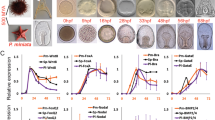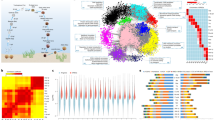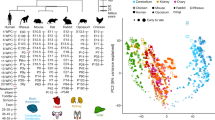Abstract
Parallels between phylogeny and ontogeny have been discussed for almost two centuries, and a number of theories have been proposed to explain such patterns1. Especially elusive is the phylotypic stage, a phase during development where species within a phylum are particularly similar to each other2,3,4,5,6. Although this has formerly been interpreted as a recapitulation of phylogeny1, it is now thought to reflect an ontogenetic progression phase2, where strong constraints on developmental regulation and gene interactions exist2,3. Several studies have shown that genes expressed during this stage evolve at a slower rate, but it has so far not been possible to derive an unequivocal molecular signature associated with this stage7,8,9,10,11,12,13,14,15. Here we use a combination of phylostratigraphy16 and stage-specific gene expression data to generate a cumulative index that reflects the evolutionary age of the transcriptome at given ontogenetic stages. Using zebrafish ontogeny and adult development as a model, we find that the phylotypic stage does indeed express the oldest transcriptome set and that younger sets are expressed during early and late development, thus faithfully mirroring the hourglass model of morphological divergence2,3. Reproductively active animals show the youngest transcriptome, with major differences between males and females. Notably, ageing animals express increasingly older genes. Comparisons with similar data sets from flies and nematodes show that this pattern occurs across phyla. Our results indicate that an old transcriptome marks the phylotypic phase and that phylogenetic differences at other ontogenetic stages correlate with the expression of newly evolved genes.
This is a preview of subscription content, access via your institution
Access options
Subscribe to this journal
Receive 51 print issues and online access
$199.00 per year
only $3.90 per issue
Buy this article
- Purchase on Springer Link
- Instant access to full article PDF
Prices may be subject to local taxes which are calculated during checkout




Similar content being viewed by others
References
Gould, S. J. Ontogeny and Phylogeny (Harvard Univ. Press, 1977)
Duboule, D. Temporal colinearity and the phylotypic progression: a basis for the stability of a vertebrate Bauplan and the evolution of morphologies through heterochrony. Dev. Suppl. 135–142(1994)
Raff, R. A. The Shape of Life: Genes Development, and the Evolution of Animal Form (Univ. Chicago Press, 1996)
Richardson, M. K. et al. There is no highly conserved embryonic stage in the vertebrates: implications for current theories of evolution and development. Anat. Embryol. (Berl.) 196, 91–106 (1997)
Hall, B. K. Phylotypic stage or phantom: is there a highly conserved embryonic stage in vertebrates? Trends Ecol. Evol. 12, 461–463 (1997)
Bininda-Emonds, O. R., Jeffery, J. E. & Richardson, M. K. Inverting the hourglass: quantitative evidence against the phylotypic stage in vertebrate development. Proc. R. Soc. Lond. B 270, 341–346 (2003)
Hanada, K., Shiu, S. H. & Li, W. H. The Nonsynonymous/synonymous substitution rate ratio versus the radical/conservative replacement rate ratio in the evolution of mammalian genes. Mol. Biol. Evol. 24, 2235–2241 (2007)
Comte, A., Roux, J. & Robinson-Rechavi, M. Molecular signaling in zebrafish development and the vertebrate phylotypic period. Evol. Dev. 12, 144–156 (2010)
Yassin, A., Lienau, E. K., Narechania, A. & DeSalle, R. Catching the phylogenic history through the ontogenic hourglass: a phylogenomic analysis of Drosophila body segmentation genes. Evol. Dev. 12, 288–295 (2010)
Davis, J. C., Brandman, O. & Petrov, D. A. Protein evolution in the context of Drosophila development. J. Mol. Evol. 60, 774–785 (2005)
Hazkani-Covo, E., Wool, D. & Graur, D. In search of the vertebrate phylotypic stage: a molecular examination of the developmental hourglass model and von Baer's third law. J. Exp. Zoolog. B 304, 150–158 (2005)
Irie, N. & Sehara-Fujisawa, A. The vertebrate phylotypic stage and an early bilaterian-related stage in mouse embryogenesis defined by genomic information. BMC Biol. 5, 1 (2007)
Roux, J. & Robinson-Rechavi, M. Developmental constraints on vertebrate genome evolution. PLoS Genet. 4, e1000311 (2008)
Cruickshank, T. & Wade, M. J. Microevolutionary support for a developmental hourglass: gene expression patterns shape sequence variation and divergence in Drosophila . Evol. Dev. 10, 583–590 (2008)
Artieri, C. G., Haerty, W. & Singh, R. S. Ontogeny and phylogeny: molecular signatures of selection, constraint, and temporal pleiotropy in the development of Drosophila . BMC Biol. 7, 42 (2009)
Domazet-Lošo, T., Brajković, J. & Tautz, D. A phylostratigraphy approach to uncover the genomic history of major adaptations in metazoan lineages. Trends Genet. 23, 533–539 (2007)
Domazet-Lošo, T. & Tautz, D. An ancient evolutionary origin of genes associated with human genetic diseases. Mol. Biol. Evol. 25, 2699–2707 (2008)
Domazet-Lošo, T. & Tautz, D. Phylostratigraphic tracking of cancer genes suggests a link to the emergence of multicellularity in metazoa. BMC Biol. 8, 66 (2010)
Parichy, D. M., Elizondo, M. R., Mills, M. G., Gordon, T. N. & Engeszer, R. E. Normal table of postembryonic zebrafish development: staging by externally visible anatomy of the living fish. Dev. Dyn. 238, 2975–3015 (2009)
Grandel, H. & Schulte-Merker, S. The development of the paired fins in the zebrafish (Danio rerio). Mech. Dev. 79, 99–120 (1998)
Leys, S. P. & Eerkes-Medrano, D. Gastrulation in calcareous sponges: In search of Haeckel’s Gastraea. Integr. Comp. Biol. 45, 342–351 (2005)
Flatt, T., Moroz, L. L., Tatar, M. & Heyland, A. Comparing thyroid and insect hormone signaling. Integr. Comp. Biol. 46, 777–794 (2006)
Arbeitman, M. N. et al. Gene expression during the life cycle of Drosophila melanogaster. Science 297, 2270–2275 (2002)
Sander, K. In Development and Evolution: the sixth Symposium of the British Society for Developmental Biology (eds Goodwin, B. C., Holder, N. & Wylie, C. C.) 137–159 (Cambridge Univ. Press, 1983)
Hill, A. A., Hunter, C. P., Tsung, B. T., Tucker-Kellogg, G. & Brown, E. L. Genomic analysis of gene expression in C. elegans . Science 290, 809–812 (2000)
Koutsos, A. C. et al. Life cycle transcriptome of the malaria mosquito Anopheles gambiae and comparison with the fruitfly Drosophila melanogaster . Proc. Natl Acad. Sci. USA 104, 11304–11309 (2007)
Domazet-Lošo, T. & Tautz, D. An evolutionary analysis of orphan genes in Drosophila . Genome Res. 13, 2213–2219 (2003)
Khalturin, K., Hemmrich, G., Fraune, S., Augustin, R. & Bosch, T. C. More than just orphans: are taxonomically-restricted genes important in evolution? Trends Genet. 25, 404–413 (2009)
Nolte, A. W., Renaut, S. & Bernatchez, L. Divergence in gene regulation at young life history stages of whitefish (Coregonus sp.) and the emergence of genomic isolation. BMC Evol. Biol. 9, 59 (2009)
Levine, M. T., Jones, C. D., Kern, A. D., Lindfors, H. A. & Begun, D. J. Novel genes derived from noncoding DNA in Drosophila melanogaster are frequently X-linked and show testis-biased expression. Proc. Natl Acad. Sci. USA 103, 9935–9939 (2006)
Kimmel, C. B., Ballard, W. W., Kimmel, S. R., Ullmann, B. & Schilling, T. F. Stages of embryonic development of the zebrafish. Dev. Dyn. 203, 253–310 (1995)
Efron, B. & Tibshirani, R. Bootstrap methods for standard errors, confidence intervals, and other measures of statistical accuracy. Stat. Sci. 1, 54–75 (1986)
Acknowledgements
We thank B. Walderich for providing zebrafish, A. Nolte, E. Blohm-Sievers, B. Kleinhenz, L. Turner and J. Bryk for laboratory support, R. Bakarić has provided the phylostratigraphic map of C. elegans, and M. Domazet-Lošo and V. Dunjko have helped with statistics. L. Boell, F. Chang and A. Pozhitkov have made suggestions on the manuscript. This work was supported by Unity Through Knowledge Fund (grant No. 49), Adris Foundation and funds of the Max-Planck Society. Computational resources were provided by CSTMB and RBI (Phylostrat Cluster).
Author information
Authors and Affiliations
Contributions
T.D.-L. conceived the basic idea and conducted the experiments; D.T. contributed to the evaluation and interpretation of the results. Both authors wrote the manuscript.
Corresponding author
Ethics declarations
Competing interests
The authors declare no competing financial interests.
Supplementary information
Supplementary Information
This file contains Supplementary Notes 1- 2, additional references and Supplementary Figures 1- 4 with legends. (PDF 1998 kb)
Rights and permissions
About this article
Cite this article
Domazet-Lošo, T., Tautz, D. A phylogenetically based transcriptome age index mirrors ontogenetic divergence patterns. Nature 468, 815–818 (2010). https://doi.org/10.1038/nature09632
Received:
Accepted:
Published:
Issue Date:
DOI: https://doi.org/10.1038/nature09632
This article is cited by
-
How ancient genes form animal body plans
Nature Reviews Genetics (2024)
-
Macroevolutionary dynamics of gene family gain and loss along multicellular eukaryotic lineages
Nature Communications (2024)
-
Genome assemblies of 11 bamboo species highlight diversification induced by dynamic subgenome dominance
Nature Genetics (2024)
-
Uncovering gene-family founder events during major evolutionary transitions in animals, plants and fungi using GenEra
Genome Biology (2023)
-
Early shape divergence of developmental trajectories in the jaw of galeomorph sharks
Frontiers in Zoology (2022)
Comments
By submitting a comment you agree to abide by our Terms and Community Guidelines. If you find something abusive or that does not comply with our terms or guidelines please flag it as inappropriate.



